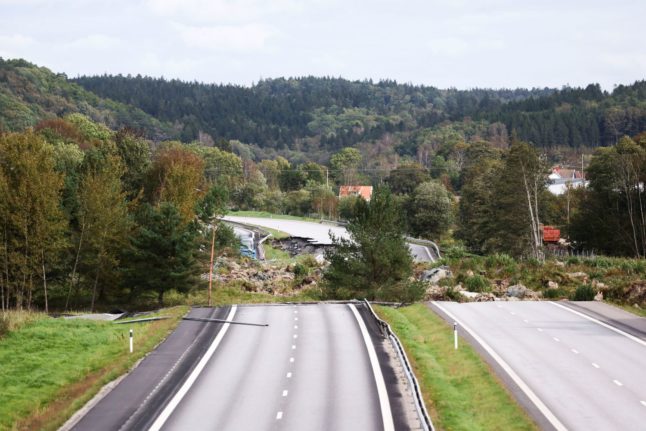Diversions
Between 10,000-12,000 vehicles usually pass the affected stretch of the E6 motorway near Stenungsund each day, on the major road leading from western Sweden to the Norwegian capital.
Normally, the drive between Gothenburg to Oslo would take around three hours in normal traffic.
WHAT HAPPENED:
However, now that the E6 is closed between Stenungsund and Ljungskile in both directions, affected travellers have two alternative routes, which both take longer.
The first option – and the option recommended by the Swedish Transport Administration – is to take the E45 motorway via Trollhätten instead, changing to the E18 at Åmål, which will take between four and a half and five and a half hours, depending on traffic.
The second option is to take the smaller 650 road, bypassing the closed section of the E6 and rejoining at Ljungskile, which you can expect to take between three and a half to four and a half hours, again depending on traffic.
These durations are only guidelines, however, and it’s worth bearing in mind that the diversion of traffic from the E6 could cause sizeable delays on both routes.
Repairs
It’s clear that it will take some time to repair the E6, considering the road has moved up to 50 metres in some places.
The Swedish Geotechnical Institute was working on Monday to assess the damage caused by the landslide in order to determine how much of the area needs to be closed for repairs.
“We’ve not managed to finish that analysis, but it’s definitely a very large amount of earth,” HannaSofie Pedersen, head of strategic climate adaptation at the Swedish Geotechnical Institute, told Swedish news agency TT.
After this analysis has been carried out it should be possible to assess the area inside the safety cordon.
“The correct area needs to be closed off, so the area outside the cordon is completely safe, without an increased risk of new landslides,” Pedersen told TT.
The chairman of Stenungsund municipality, Olof Lundberg, told Sveriges Radio that he wants repairs completed within six months in order to minimise the effects of the road closure on the region.
“Large areas of western Sweden will suffer because of this,” he told the radio, while admitting that six months was an “optimistic” goal.
“It’s too early to say [when the road will be fixed]” Swedish Transport Administration press officer Pär Aronsson told The Local on Monday, stating only that it would take “a number of months”.
When asked whether Lundberg’s six-month goal was realistic, Aronsson said that the Transport Administration was unable to comment, but that it “would become clearer” once they were able to take a closer look at the site.
How could it affect the region?
One of the roads closed off due to the landslide is the E6 exit at Stenungsund, which is considered especially important for industry in the area, Sveriges Radio reports.
Stenungsund municipality chair Lundberg also pointed out that the diversions, which add around 45 minutes to commuters’ journeys, will affect many locals.
“This is an artery through Bohuslän up to Norway,” Lundberg told the radio. “It’s going to be difficult.”
He added that the municipality would most likely need government support for the repairs, although he wasn’t sure exactly what – or how much money – it would need.
“Initially at least, it looks like we will be able to manage quite a bit by ourselves, but as time goes on we’ll have to look closer at what sort of help we might need.”



 Please whitelist us to continue reading.
Please whitelist us to continue reading.
Member comments